NCERT Solutions for Class 12 Macro Economics Chapter-4 Banking
NCERT TEXTBOOK QUESTIONS SOLVED
1. Explain the functions of a commercial bank?
Ans:
Deleted from syllabus.
2. What is money multiplier? How will you determine its value? What ratios play an important role in the determination of the value of the money multiplier? [3-4 Marks]
Ans:
- When the primary cash deposit in the banking system leads to multiple expansion in the total deposits, it is known as money multiplier or credit multiplier.
-
The value of Money Multiplier
\(=\frac { 1 }{ LRR } \)
where LRR = Legal Reserve Ratio. - Legal Reserve Ratio: It is the minimum ratio of deposits legally required to be kept by the commercial banks with themselves and with the central bank.
-
So, there are two ratios which play an important role in the determination of the value of the money multiplier. They are:
(a) Cash Reserve Ratio: It refers to the minimum percentage of a bank’s total deposits, which it is required to keep with the central bank.
(b) Statutory Liquidity Ratio: It refers to minimum percentage of net total demand and time liabilities, which commercial banks are required to maintain with themselves.
3. What are the instruments of monetary policy of RBI? How does RBI stabilize money supply against exogenous shocks? [6 Marks]
Ans:
-
Principal instruments of Monetary Policy or credit control of the Central Bank of a country(RBI) are broadly classified as:
(a) Quantitative Instruments,
• Bank Rate
• Repo rate
• Reverse Repo rate
• Open Market Operations (OMO)
• Varying Reserve Requirements (fa) Qualitative Instruments
• Imposing margin requirement on secured loans
• Moral Suasion
• Selective Credit Controls (SCCs) -
RBI stabilize money supply against exogenous shocks in the following manner:
(a) Bank Rate (Discount Rate)
• Bank rate is the rate of interest at which central bank lends to commercial banks without any collateral (security for purpose of loan). The thing, which has to be remembered, is that central bank lends to commercial banks and not to general public.
• In a situation of excess demand leading to inflation,
> Central bank raises bank rate that discourages commercial banks in borrowing from central bank as it will increase the cost of borrowing of commercial bank.
> It forces the commercial banks to increase their lending rates, which discourages borrowers from taking loans, which discourages investment.
> Again high rate of interest induces households to increase their savings by restricting expenditure on consumption.
> Thus, expenditure on investment and consumption is reduced, which will control the excess demand.
• In a situation of deficient demand leading to deflation,
> Central bank decreases bank rate that encourages commercial banks in borrowing from central bank as it will decrease the cost of borrowing of commercial bank.
> Decrease in bank rate makes commercial bank to decrease their lending rates, which encourages borrowers from taking loans, which encourages investment.
> Again low rate of interest induces households to decrease their savings by increasing expenditure on consumption.
> Thus, expenditure on investment and consumption increase, which will control the deficient demand.
(b) Open Market Operations (OMO)
• It consists of buying and selling of government securities and bonds in the open market by central bank.
• In a situation of excess demand leading to inflation, central bank sells government securities and bonds to commercial bank. With the sale of these securities, the power of commercial bank of giving loans decreases, which will control excess demand.
• In a situation of deficient demand leading to deflation, central bank purchases government securities and bonds from commercial bank. With the purchase of these securities, the power of commercial bank of giving loans increases, which will control deficient demand.
(c) Imposing margin requirement on secured loans
• Business and traders get credit from commercial bank against the security of their goods. Bank never gives credit equal to the full value of the security. It always pays less value than the security.
• So, the difference between the value of security and value of loan is called marginal requirement.
• In a situation of excess demand leading to inflation, central bank raises marginal requirements. This
discourages borrowing because it makes people gets less credit against their securities.
• In a situation of deficient demand leading to deflation, central bank decreases marginal requirements. This encourages borrowing because it makes people get more credit against their securities.
(d) Moral Suasion
• Moral suasion implies persuasion, request, informal suggestion, advice and appeal by the central banks to commercial banks to cooperate with general monetary policy of the central bank.
• In a situation of excess demand leading to inflation, it appeals for credit contraction.
• In a situation of deficient demand leading to deflation, it appeals for credit expansion.
4. Do you consider a commercial bank ‘Creator of money’ in the economy?
[6 Marks] Or
Explain the process of money creation/deposit creation/credit creation by the commercial banking system. [CBSE 2010, IOC, 11] Or
Giving a numerical example, explain the process of money creation by commercial banks.
[Sample Paper 2013], Or
How do commercial banks create deposits? Explain. [CBSE 2013 (Set II)] Or
Explain the credit creation role of commercial banks with the help of a numerical example.
Or
Explain briefly the working of money multiplier. [AT 2013, C]
Ans:
Yes, commercial bank acts as a ‘Creator of money’ in the economy. It can be explained with the help of Credit creation process:
- Let us assume that the entire commercial banking system is one unit. Let us call this one unit simply “banks’. Let us also assume that all receipts and payments in the economy are routed through the banks. One who makes payment does it by writing cheque. The one who receives payment deposits the same in his deposit account.
- Suppose initially people deposit Rs 1000. The banks use this money for giving loans. But the banks cannot use the whole of deposit for this purpose. It is legally compulsory for the banks to keep a certain minimum fraction of these deposits as cash. The fraction is called the Legal Reserve Ratio (LRR). The LRR is fixed by the Central Bank.
- Let us now explain the process, suppose the initial deposits in banks is Rs 1000 and the LRR is 10 percent. Further, suppose that banks keep only the minimum required, i.e., Rs 100 as cash reserve, banks are now free to lend the remainder Rs 900. Suppose they lend Rs 900. What banks do to open deposit accounts in the.names of the borrowers who are free to withdraw the amount whenever they like. Suppose they withdraw the whole of amount for making payments.
- Now, since all the transactions are routed through the banks, the money spent by the borrowers comes back into the banks into the deposit accounts of those who have received this payment. This increases demand deposit in banks by Rs 900. It is 90 per cent of the initial deposit. These deposits of Rs 900 have resulted on account of loans given by the banks. In this sense the banks are responsible for money creation. With this round increase in total deposits is now Rs 1900 (=1000 + 900).
-
When banks receive new deposit of ?900, they keep 10 per cent of it as cash reserves and use the remaining Rs 810 for giving loans. The borrowers use these loans for making payments. The money comes back into the
accounts of those who have received the payments. Bank deposits again rise, but by a smaller amount of Rs 810. It is 90 per cent of the last deposit creation. The total deposits now increase to Rs 2710 (=1000 + 900 + 810). The process does not end and continues till total deposit creation comes to ? 10000, ten times the initial deposit as shown in the table below.
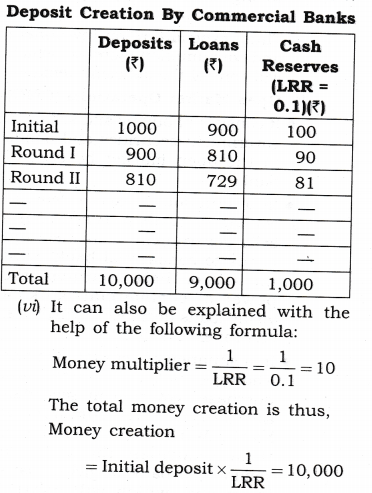
5. What role of RBI is known as ‘Lender of last Resort’? [3 Marks]
Ans:
- As banker to the banks, the central bank acts as the lender of the last resort.
- In other words, in case the commercial banks fail to meet their financial requirements from other sources, they can, as a last resort, approach to the central bank for loans and advances.
- The central bank assists such banks through discounting of approved securities and bills of exchange.
MORE QUESTIONS SOLVED
I.VERY SHORT ANSWER TYPE QUESTIONS (1 Mark)
1. Define commercial bank.
Ans:
Commercial bank is a financial institution which performs the functions of accepting deposits from the public and making loans and investments, with the motive of earning profit.
2. Define money multiplier/credit multiplier/deposit multiplier.
Ans:
When the primary cash deposit in the banking system leads to multiple expansion in the total deposits, it is known as money multiplier or credit multiplier.
3. Define central bank. [CBSE 2008, 09; A 08]
Ans:
The central bank is the apex institution of a country’s monetary system. The design and the control of the country’s monetary policy is its main responsibility. India’s central bank is the Reserve Bank of India.
4. Define bank rate. [CBSE 2009]
Ans:
It is the rate of interest at which central bank lends to commercial banks without any collateral (security for purpose of loan).
5. What will be the effect of a rise in bank rate on the money supply? [CBSE Sample Paper 2008]
Ans:
Money supply will reduce.
6. Define open market operations.
Ans:
It consists of buying and selling of government securities and bonds in the open market by central bank.
7. What is meant by cash reserve ratio? [CBSE 2011, CBSE Sample Paper 2008, 2013]
Ans:
Cash Reserve Ratio refers to the minimum percentage of a bank’s .total deposits, which it is required to keep with the central bank.
8. What is meant by statutory liquidity ratio? [CBSE Sample Paper 2010]
Ans:
It refers to minimum percentage of net total demand and time liabilities,
which commercial banks are required to maintain with themselves.
II. MULTIPLE CHOICE QUESTIONS (1 Mark)
1. Which one of the following institutions is not a bank?
(a) HDFC (b) LIC
(c) UTI (d) All of them
Ans:
(d)
2. Quantitative instrument of RBI can be:
(a) Bank Rate policy
(b) Cash Reserve Ratio
(c) Statutory Liquidity Ratio
(d) All of them
Ans:
(d)
3.refers to that portion of
total deposits of a commercial bank which it has to keep with RBI in the form of cash reserves.
(a) CRR (b) SLR .
(c) Bank Rate (d) Repo Rate
Ans:
(a)
4.refers to that portion of total deposits of a commercial bank which it has to keep with itself in the form of liquid assets.
(a) CRR (b) SLR
(c) Bank Rate (d) Repo Rate
Ans:
(b)
5. In order to control credit in the country, the RBI may
(a) buy securities in the open market
(b) sell securities in the open market
(c) reduce CRR
(d) reduce bank rate
Ans:
(b)
6. In order to encourage investment in
the country, the RBI may
(a) reduce CRR. (b) increase CRR.
(c) sell securities in the open market.
(d) increase bank rate.
Ans:
(a)
7. In order to discourage investment in the economy, the RBI may
(a) Increase bank rate
(b) decrease bank rate
(c) buy securities in the open market
(d) decrease CRR
Ans:
(a)
8. The effect of increase in CRR will be
reduced or nullified if
(a) bank rate is reduced
(b) securities are sold in the open market
(c) SLR is increased
(d) people do not borrow from non-banking institutions
Ans:
(a)
9. In order to control credit
(a) CRR should be increased and bank rate should be decreased
(b) CRR should be reduced and bank rate
should be reduced
(c) CRR should be increased and bank rate should be increased
(d) CRR should be reduced and bank rate should be increased
Ans:
(c)
10. controls affect indiscriminately all sectors of the economy.
(a) Selective credit
(b) Quantitative
(c) Margin requirements
(d) None of the above
Ans:
(b)
11. During depression, it is advisable to
(a) lower bank rate and purchase securities in the market
(b) increase bank rate and purchase securities in the open market
(c) decrease bank rate and sell securities in the open market.
(d) increase bank rate and sell securities in the open market
Ans:
(a)
12. The ‘lender of last resort’ means
(a) the government coming to the rescue of poor farmers.
(b) Central Bank coming to the rescue of other banks in times of financial crisis.
(c) commercial banks coming to the rescue of small industrial units.
(d) None of them.
Ans:
(b)
13. Who is called the ‘bank of issue’?
(a) RBI (b) SBI
(c) IDBI (d) ICICI
Ans:
(a)
14. Who is the fiscal agent and adviser to government in monetary and financial matters in India?
(a) SBI (b) IDBI
(c) ICICI (d) RBI
Ans:
(d)
15. Who is the custodian of national reserves of international currency?
(a) SBI (b) IDBI
(c) RBI (d) ICICI
Ans:
(c)
16. If an economy is to control recession like most of the Euro-Zone nations, which of the following can be appropriate:
[CBSE Sample Paper 2016]
(a) Reducing Repo Rate
(b) Reducing CRR
(c) Both (i) and (ii)
(d) None of (i) and (ii)
Ans:
(c)
III. SHORT ANSWER TYPE QUESTIONS[3-4 Marks]
1. Explain issue of currency function of Central Bank.
[CBSE 2004C, 06; AI 11] Or
Explain the “Bank of Issue Function” of the central Bank.[CBSE, AI 2015]
Ans:
- The central bank has the sole monopoly to issue currency notes. Commercial banks cannot issue currency notes. Currency notes issued by the central bank are the legal tender money.
- Legal tender money is one, which every individual is bound to accept by law in exchange for goods and services and in the discharge of debts.
- Central bank has an issue department, which is solely responsible for the issue of notes.
- However, the monopoly of central bank to issue the currency notes may be partial in certain countries.
- For example, in India, one rupee notes and all coins are issued by the government and all other notes are issued by the Reserve Bank of India.
2. Explain banker to the government function of a Central Bank.[CBSE 2013, 06C; AI 08; 10]
Or
Explain “Government’s Bank” function of Central Bank.[CBSE 2015]
Ans:
As a banker to the government, the central bank performs same functions as performed by the commercial banks to their customers.
- It receives deposits from the government and collects cheques and drafts deposited in the government account.
- It provides cash to the government as resumed for payment of salaries and wages to their staff and other cash disbursements.
- It makes payments on behalf of the government.
- It also advances short term loans to the government.
- It supplies foreign exchange to the government for repaying external debt or making other payments.
3. Explain the “banker’s bank ’ function of a central bank.[Al 2015, 2007, 11, CBSE 13, Al]
Ans:
Central bank acts as the banker to the banks in three ways :
- custodian of the cash reserves of the commercial banks;
- as the lender of the last resort; and
- as clearing agent.
- As a custodian of the cash reserves of the commercial banks, the central bank maintains the cash reserves of the commercial banks. Every commercial bank has to keep a certain percent of its cash reserves with the central bank by law.
-
As Lender of the Last Resort.
(a) As banker to the banks, the central bank acts as the lender of the last resort.
(b) In other words, in case the commercial banks fail to meet their financial requirements from other sources, they can, as a last resort, approach to the central bank for loans and advances. -
The central bank assists such banks through discounting of approved securities and bills of exchange.
(c) As Clearing Agent
(i) As the custodian of the cash reserves of the commercial banks, the central bank acts as the clearing house for these banks.
(ii) Since all banks have their accounts with the central bank, the central bank can easily settle the claims of various banks against each other simply by book entries of transfers from and to their accounts.
(iii) This method of settling accounts is called Clearing House Function of the central bank.
4. How does central bank control availability of credit by open market operations?[CBSE 2005, 06C, 11C; AT 04, 10]
Ans:
- Open Market Operation consists of buying and selling of government securities and bonds in the open market by central bank.
- To control availability of credit, central bank sells government securities and bonds to commercial bank.
- With the sale of these securities, the power of commercial banks of giving loans decreases.
5. What is Legal Reserve Ratio? Explain its components. [AI 2013, C (Set 1)]
Ans:
- Legal Reserve Ratio: It is the minimum ratio of deposits legally required to be kept by the commercial banks with themselves and with the central bank.
-
It’s components are:
(a) Cash Reserve Ratio: It refers to the minimum percentage of a bank’s total deposits, which it is required to keep with the central bank.
(b) Statutory Liquidity Ratio: It refers to minimum percentage of net total demand and time liabilities, which commercial banks are required to maintain with themselves.
6. Differentiate between central bank and commercial bank.
Or
State any three points of distinction between central bank and commercial bank.[CBSE 2009]
Ans:
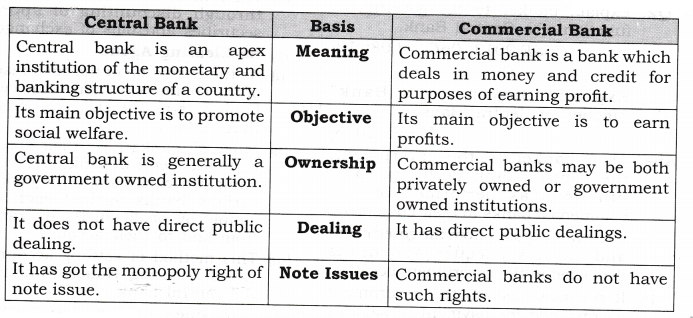
IV.TRUE OR FALSE
Giving reasons, state whether the following statements are true or false.
1. Increase in statutory liquidity ratio adversely affects the capacity of commercial banks to create credit.
Ans:
True.
An increase in statutory liquidity ratio reduces the excess reserves of commercial banks and limits their credit creating power.
2. Sale of securities in the open market by the commercial banks reduces their crediting power.
Ans:
False.
Purchase of securities decreases the reserves of commercial banks, which reduces their crediting power, not the sale of securities in the open market.
3. Cash reserve ratio and statutory liquidity ratio are fixed by the central bank.
Ans:
True.
They are fixed by central bank under quantitative instruments of credit control.
4. Under marginal requirement, the Reserve Bank of India gives directions to other banks to channelise credit to priority sectors.
Ans:
False.
It happens under selective credit controls.
5. There is an inverse relationship between legal reserve ratio (LRR) and value of money multiplier.
Ans:
True.
Money multiplier is inversely related to LRR as Money Multiplier
\(=\frac { 1 }{ LRR } \)
6. To increase the money supply in the economy central bank increases the margin requirements.
Ans:
False.
Rise in margin requirements discourages the borrowing capacity of public which decreases the money supply in the economy.

V.LONG ANSWER-TYPE QUESTION(6 Marks)
1. (i) What is meant by Cash Reserve Ratio? How does it increase the money Supply in the economy? (ii) What is meant by Open Market Operation? How does it reduce the money supply in the economy?[CBSE Sample Paper 2014][(3 + 3)]
Ans:
-
Cash Reserve Ratio:
(a) It refers to the minimum percentage of a bank’s total deposits, which it is required to keep with the central bank. Commercial banks have to keep with the central bank a certain percentage of their deposits in the form of cash reserves as a matter of law.
(b) For example, if the minimum reserve ratio is 10% and total deposits of a certain bank is ?100 crore, it will have to keep Rs 10 crore with the central bank.
(c) To increase Money supply in an economy, cash reserve ratio (CRR) falls to 5 per cent, the bank will have to keep Rs 5 crore with the central bank, which will increase the cash resources of commercial bank and increasing credit availability in the economy, which will increase the money supply in an economy. -
Open Market Operation:
(a) It consists of buying and selling of government securities and bonds in the open market by central bank.
(b) To reduce Money Supply in an economy, central bank sells government securities and bonds to commercial bank. With the sale of these securities, the power of commercial bank of giving loans decreases, which will reduce the money supply in an economy.
VI. HIGH ORDER THINKING SKILLS
1. Differentiate between quantitative and qualitative instruments of credit control. [3 Marks]
Ans:
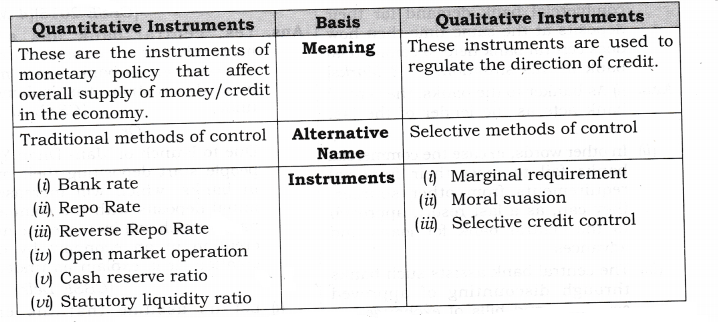
2. Calculate the value of money multiplier and total deposit created if initial deposit is of Rs 1,000 crore and LRR is 20%. [3 Marks]
Ans:
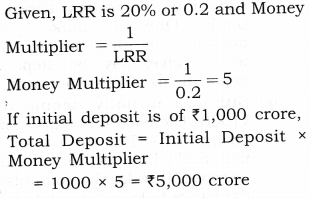
3.If the total deposits created by commercial banks is Rs 10,000 crore and legal reserve requirements is 10%, calculate the amount of initial deposits. [3 Marks]
Ans:
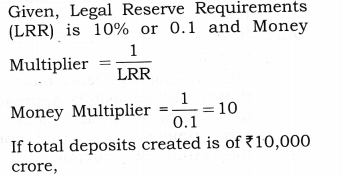
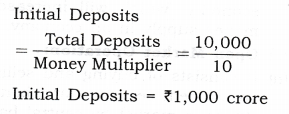
VII. VALUE BASED QUESTIONS
1. In the situation of inflation credit creation by commercial bank is beneficial for the bank but it explain its negative impact on economy.[1 Mark]
Ans:
Money creation by commercial bank in the condition of rising prices increases money supply. It creates the situation of excess demand and consequently again increases the price level.
Value:
Analytic.
2. Suppose all the customers of a commercial bank demand for their deposits at the same time then how does central bank help to commercial bank in this situation. [3 Marks]
Ans:
- As banker to the banks, the central bank acts as the lender of the last resort.
- In other words, in case the commercial banks fail to meet their financial requirements from other sources, they can, as a last resort, approach to the central bank for loans and advances.
- The central bank assists such banks through discounting of approved securities and bills of exchange. Value: Analytic.
VIII. APPLICATION BASED QUESTIONS
1. Why are the banks required to keep only a fraction of deposits as cash reserves? [3 Marks]
Ans:
It is because of the following two reasons:
- The banking experience has revealed that not all depositors approach the banks for withdrawal of money at the same time and also that normally they withdraw a fraction of deposits.
- There is a constant flow of new 150 deposits into the banks. Therefore to meet the daily demand for withdrawal of cash, it is sufficient for banks to keep only a fraction of deposits as a cash reserve.
2. Currency is issued by the central bank, yet we say that commercial banks create money. Explain. How is this money creation by commercial banks likely to affect the national income? Explain.
[CBSE AI 2015][4 Marks] Or
Government of India recently launched ‘Jan-Dhan Yojna’ aimed at every household in the country to have at least one bank account. Explain how deposits made under the plan are going to affect national income of the country.
[CBSE 2015][4 Marks]
Ans:
Yes, central bank has a sole monopoly power to issue currency, but commercial bank create money by credit creation. It is explained as under: [CBSE AI 2015]
Or
Due to launch of “Jan- Dhan Yojna” people start depositing their money in banks, which will increase the initial deposits with the commercial bank, which will increase the money creation in an economy by credit creation. It is explain as under:[CBSE Delhi 2015]
- Let us assume that the entire commercial banking system is one unit. Let us call this one unit simply “banks’. Let us also assume that all receipts and payments in the economy are routed through the banks. One who makes payment does it by writing cheque. The one who receives payment deposits the same in his deposit account.
- Suppose initially people deposit ?1000. The banks use this money for giving loans. But the banks cannot use the whole of deposit for this purpose. It is legally compulsory for the banks to keep a certain minimum fraction of these deposits as cash. The fraction is called the Legal Reserve Ratio (LRR). The LRR is fixed by the Central Bank.
- Let us now explain the process, suppose the initial deposits in banks is ?1000 and the LRR is 10 percent. Further, suppose that banks keep only the minimum required, i.e., ^100 as cash reserve, banks are now free to lend the remainder ?900. Suppose they lend ?900. What banks do to open deposit accounts in the names of the borrowers who are free to withdraw the amount whenever they like. Suppose they withdraw the whole of amount for making payments.
- Now, since all the transactions are routed through the banks, the money spent by the borrowers comes back into the banks into the deposit accounts of those who have received this payment. This increases demand deposit in banks by Rs 900. It is 90 per cent of the initial deposit. These deposits of Rs 900 have resulted on account of loans given by the banks. In this sense the banks are responsible for money creation. With this round increase in total deposits is now Rs 1900 (=1000 + 900).
- When banks receive new deposit of Rs 900, they keep 10 per cent of it as cash reserves and use the remaining ?810 for giving loans. The borrowers use these loans for making payments. The money comes back into the accounts of those who have received the payments. Bank deposits again rise, but by a smaller amount of Rs 810. It is 90 per cent of the last deposit creation. The total deposits now increase to Rs 2710 (= 1000 + 900 + 810). The process goes on till the total deposit creation comes to Rs 10000, ten times the initial deposit as shown in the table below.
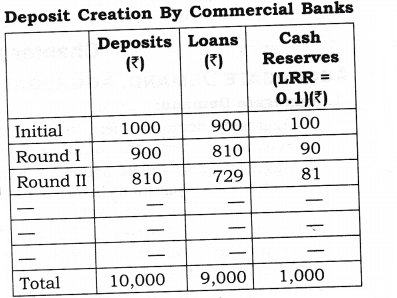
So, with initial deposit of 1000, money creation or money supply increase by 10,000, which will increase the contribution in the flow of goods and services, which will thereby increase the national income. [CBSE (AI) 2015]
NCERT Solutions Accountancy Business Studies Macro Economics Commerce